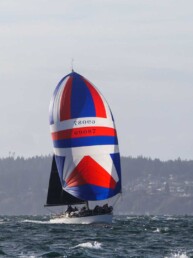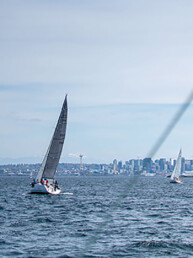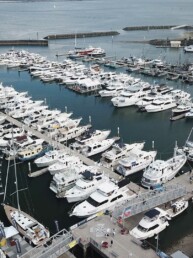The summer sun beat down as I tugged my battered Laser up the even more worn boat ramp. Just in from a frigid sail, full of sloppy roll tacks and practice for my upcoming sophomore year of racing, I scanned Port Townsend Bay with my eye out for any other small vessels. A minefield of anchored cruisers occupied the shallows, along with a plethora of crab pots extending to the shores of Indian Island. It’s a wonder any of us make it through there. Lost in thought, it was only after I heard my name that I realized that there was anyone else there.
I didn’t recognize the person talking to me, even though he appeared to know me. Living in a small town like Port Townsend, people seem to know each other even if they haven’t met before—as it happens, this fellow had once rented my parents’ house. It’s not uncommon for me to wind up chatting at the boat ramp; almost every time I take out my Laser, I get a friendly smile or curious comment, “What type of boat is that?” or the classic, “I used to sail those when I was your age!” Conversing as I derigged, I learned that this man raced in the local Thunderbird one design fleet. By the time my sail was rolled and my boat rinsed off, I had an invitation to go racing.
Ever since I began to immerse myself in the Port Townsend sailing community, I have heard about Thunderbirds. It’s hard to avoid them, as most of the avid sailors in the area are involved in the fleet in one way or another, and T-birds represent around a third of the PHRF fleet. One of my high school teammates had raced on one, and often referenced it in a rather melodramatic manner yet, to this point, I had never considered trying to find my own place on one.
Wednesday race night came and I found myself down on the docks, searching. I only knew the first name and number of the person who invited me, and he wasn’t answering his phone. Crews were taking sail covers off, bending on sails, and a few had even cast off. I was getting desperate. I asked around, only to find that there were multiple sailors with the same name and the one I managed to find was certainly not him. I was just about to give up and bike home when Hans, the skipper of a utilitarian white Thunderbird named Possum, offered me a spot on his crew.
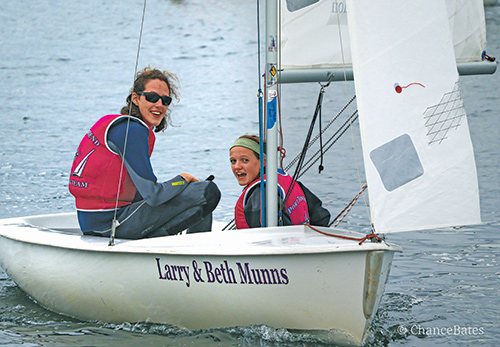
Introduction to the Fleet
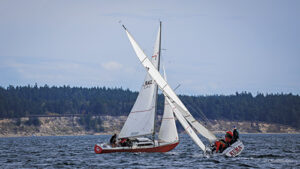
Hans had recently started his own team on Possum and had just one consistent crew. My friend Noah and I quickly filled this vacancy, making us by far the youngest team on the race course, and possibly the only one where no one had white hair. We went out that first night and instantly had fun together, along with some ups and downs. Our races had a very consistent pattern. We would start well and round the weather mark in first but, after that, it would go downhill quickly. Often it was the spinnaker, something would get stuck and cause a slow hoist or an hourglass. Other times it was a wide rounding or we’d pick the wrong side and get rolled—something that happened much more frequently downind than upwind.
I was captivated after that first night. When I first stepped on the boat, Hans described it as a large 420. On a literal level this comparison holds up pretty well, yet the racing is different. As someone who had only sailed dinghies and wooden schooners, actual close keelboat starts were alarming. Fortunately this was one aspect of the race that my skipper had down, which at the time appeared as wizardry to me. Tactically, you had to commit to a side far more than I did in dinghies, because the size of the fleet and the risk of doing too many maneuvers on a 3,600-pound 26-foot keelboat could get you in trouble. But these starts taught me valuable lessons that have improved my dinghy racing.
After racing, whoever was available would meet in the clubhouse to socialize and discuss the day. A lot of what I’ve learned about tactics and strategy came from these meetings. Comparing dinghy tactics—with their snappy tacks—and keelboat tactics has helped me understand both to a much higher level. Coming from dinghies, which tend to perform best when hiked flat, sailing with heel was a completely foreign concept to me. One of the first questions I asked was about how much heel was fastest, with the answer being the unsatisfactory, “whatever feels good.” I’ve asked many more questions at those meetings since then, most of which came with far more solid answers.
Racing with Hans didn’t last more than a season, as pretty soon my high school racing schedule conflicted. Yet when the dinghy season was over, it took no effort to find a boat to crew on, as everyone is very welcoming and there’s often at least a couple crews who are missing their fourth. Ever since that first season, I typically run the bow, since I’ve always been the youngest member of the crew. Not only do I enjoy bow, but I’m often nominated for the role due to my ‘spryness.’ One of my favorite parts of sailing the Thunderbird is setting and jibing the spinnaker in breeze on the notoriously slippery bow—such crucial parts of the race, they are immensely satisfying when done right. These successes made up for the stress of my mistakes and fouled sets when I was first starting out.
The Venerable Thunderbird

The Thunderbird is a hard chined fractional sloop designed by Ben Seaborn. As Pacific Northwest sailors are likely aware, the Thunderbird was chosen as the winner of a 1958 contest held by the Douglas Fir Plywood Association. The contest called contestants to draw up a boat that, according to the International Thunderbird Class Association, was to “be both a racing and cruising boat, sleep four, be capable of being built by reasonably skilled amateurs, be powered by an outboard, and out-perform other sailboats.” The boat neatly fits this criteria and ended up at 26-feet of length overall. The interiors are spartan, with four bunks, a small sink, and generally not much more.
First built in Gig Harbor, the Thunderbird enjoyed immediate popularity. Just two years after the initial design, the class association was formed, with the first fleets being located in Tacoma and Seattle. It was not long until the excitement grew and fleets started popping up in Canada and California, and even Boston, Australia, and Japan. In the early 1970s, the class adopted fiberglass as a new hull material, along with an aluminum mast and a high aspect rudder. These additions kept the excitement flowing, with production fiberglass hulls being built in Vancouver, Ontario, and Sydney. Wooden and fiberglass hulls still race equally under the one design rule. At the height of class activity, more than 50 boats would attend the international championship regattas.
The first Thunderbirds reached Port Townsend in the early 1960s, when three friends, Glenn Abraham, Bill Scheyer, and Jim Daubenberger, each purchased boats; yet it was many years until the local fleet really took off.
Thunderbirds are charming boats, which look pretty under sail and slightly awkward at the dock. “Quirky” was the word used by Piper Dunlap, a longtime sailor and an initiator of the Port Townsend fleet’s renaissance. He drove all the way to the East Coast in 2014 for his first Thunderbird, Blewbird. As a firm supporter of one design racing, he was quick to sell his J/27 to be part of the growing class. He described Thunderbirds as being “designed to be the VW bus,” as in they are cute, somewhat comfortable, and you can bring your family along. They have a deep cockpit, benches, and a sharp coaming, which can get tiring after a couple days of driving from the rail. Dulap related their comfort to a 505 dinghy. “After racing three days on a T-bird, I am wrecked. After racing three days on a 505, I feel pretty good!” Both Blewbird and Merlin, two Thunderbirds that are regularly raced in the fleet, were brought into town by Dunlap.
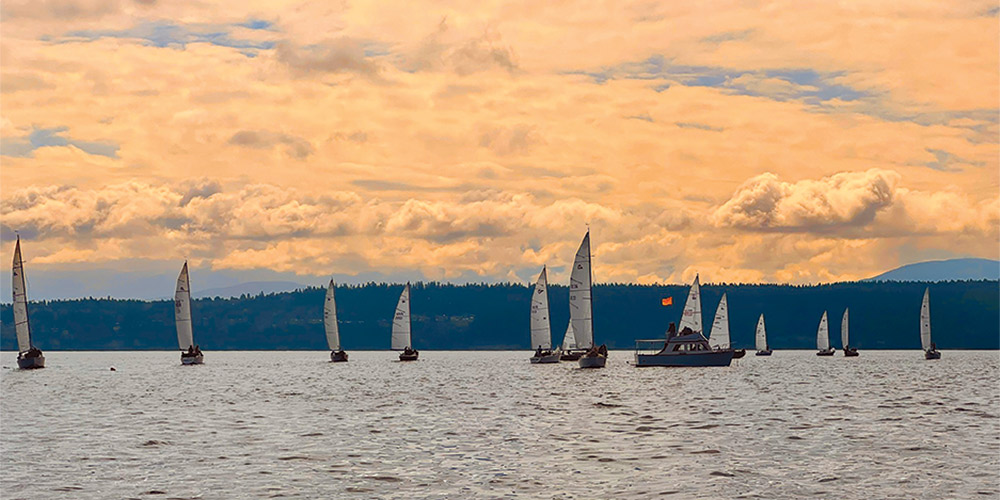
Thunderbird Racing and Fleets
Thunderbirds may not win many races boat-for-boat these days, but they are still relatively quick with a favorable PHRF rating of 195 and can dominate in lighter air. It’s not uncommon to see them sweep PHRF leaderboards. In an attempt to get more people to race PHRF, the Port Townsend Sailing Association knocked their rating down 45 points, which was, predictably, a very contentious issue. Even that wasn’t enough to keep them out of the season rankings. They’re rigged with a symmetrical spinnaker and either a genoa or smaller non-overlapping jib for the windier days. While sportboats and vessels with more waterline outpace the Thunderbirds in a breeze, their symmetrical spinnaker and decently low wetted surface area help them get ahead on light air days.
Today, there are many T-birds scattered around the region, yet the closest fleet that can rival Port Townsend’s in number and activity is in Boston. The Thunderbird has a lot going for it as an extremely accessible one design, especially in areas where there’s a large fleet. In addition to being quick, they are relatively easy to sail and can be found cheap. This is very obvious in Port Townsend, where you see them scattered everywhere. They’re all throughout the port and the boatyard, even hidden in people’s yards and driveways. According to Roland Nikles, the president of the Port Townsend Sailing Association in 2023, there are 22-25 boats in Port Townsend and Sequim combined.
Any one design class thrives on its community, as the number of boats is what makes the racing intense. The T-bird fleet is a great example of this and exhibits camaraderie in many ways. If there were any annoyances or hard feelings after a day of racing, they are promptly forgotten as the fleet heads back to the clubhouse for a debrief or to socialize. On exceedingly windy or calm days, the fleet leaders stay at the dock and will give talks or lead less experienced crews through mock maneuvers. The sharing of skills and knowledge is very important because, while it is accessible, it draws some of the area’s most accomplished sailors as well. As someone who recently entered the fleet I can attest that it has been great to feel like I can contribute immediately, but I can also learn a lot from the more experienced sailors.
It has been subtly different sailing in the T-bird community versus racing in high school, as everyone in the fleet knows each other. At high school regattas, the camaraderie is more amongst your team and the few other friends you’ve made in the fleet. Even though there are comparatively similar levels of competitive spirit, it’s wielded in a much softer manner in the Thunderbird fleet.
The Thunderbird community in Port Townsend has some of the most dedicated sailors on the bay. They’re the first ones out in the new year and the last ones to quit in the fall. They race in one series or another all the way from April through October, and Saturday practices start on the first weekend of January. They are a seemingly constant sight on Port Townsend Bay, more so than any other vessels except the ferry. That dedication is necessary when racing one design. In a fleet that starts so even, getting out on the water even a month early can give you a significant head start on the competition. Yet it’s more than that. They get out early for the joy of being on the water and the satisfaction of pushing their boats as fast as they can make them go. This is a welcome change to high school sailing, where almost everything is in the context of purely racing, and one of the most refreshing reasons why I’m involved in the fleet.
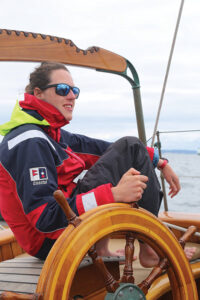
When I first stepped aboard Possum, I had no idea that I would still be racing Thunderbirds today, especially because the uncertainty of that first day might well have meant I never started sailing with this fleet. Since then, I have sailed regularly on three different boats and know all the boats and most of the sailors in the fleet by name. The welcoming attitude of the community has inspired me to reach out to more people. Whether it’s about sailing or connecting with the wider community, this spirit has given me multiple opportunities that couldn’t have happened if I hadn’t simply started a conversation.
The last time I sailed a Thunderbird was on Dorado, the boat Jim Daubenberger first brought to Port Townsend in the 60s—history is never too distant in this town and this fleet. I was running bow for Piper Dunlap with a crew of three. It was ghosting weather and dying, eventually becoming too patchy to race. The fleet headed in early yet, even with barely any wind at all, very few people reached into the outboard well to start the motor. They were Port Townsend T-bird sailors, why would they rush to head in?
Ocean Smith is a high school sailor and aspiring journalist living in Port Townsend. As his senior project, he’s been interning with 48° North.

